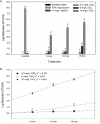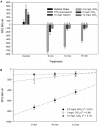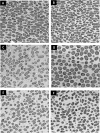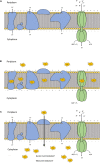Integrity of the Escherichia coli O157:H7 Cell Wall and Membranes After Chlorine Dioxide Treatment
- PMID: 32499765
- PMCID: PMC7243733
- DOI: 10.3389/fmicb.2020.00888
Integrity of the Escherichia coli O157:H7 Cell Wall and Membranes After Chlorine Dioxide Treatment
Abstract
Treatments of wastewater and fresh produce commonly employ chlorine as an antimicrobial. However, there are increasing levels of concerns regarding the safety and antimicrobial efficacy of chlorine treatments. Numerous studies have reported the antimicrobial properties of chlorine dioxide (ClO2) treatment in a variety of applications but information regarding how ClO2 affects bacteria is limited. In the present study, a mixed-method approach utilizing both quantitative and qualitative methodologies was used to observe Escherichia coli O157:H7 membrane damage after exposure to ClO2 (2.5, 5, or 10 mg/L) for 5, 10, or 15 min. For comparison, controls of 0.1% peptone, 70% isopropanol, and 10 mg/L NaOCl were applied for 15 min. After treatment, cells were enumerated on selective media overlaid with non-selective media and simultaneously analyzed for damage using the following fluorescent probes (1) Bis-(1,3-Dibutylbarbituric Acid) trimethine oxonol (DiBAC4(3)) for membrane polarization, (2) SYTO 9/propidium iodide (LIVE/DEAD) for membrane permeability, (3) 2-(N-(7-Nitrobenz-2-oxa-1,3-diazol-4-yl)Amino)-2-Deoxyglucose (2-NBDG) for active glucose uptake, and (4) lipid peroxidation through accumulation of malondialdehyde (MDA). Bacterial log reductions after ClO2 treatment ranged from 0.2 to 5.5 and changes in relative fluorescence units after membrane permeability and glucose uptake assays were not consistent with viability, indicating membrane permeability and metabolism were not substantially altered. Depolarization was observed after NaOCl treatment, however, the polarity of cells treated with ClO2 were like those treated with water (P < 0.05). Accumulation of MDA was detected only after 10 mg/L ClO2 treatments, indicating that membrane peroxidation occurred at higher concentrations. Transmission electron microscopy imaging revealed that separation of the cell wall from the cytosol occurred after the 10 mg/L ClO2 treatment, but the cell wall itself appeared to be unbroken. These data suggest that ClO2 damage to E. coli O157:H7 is not primarily located at the cell wall and harms cells significantly different than NaOCl at comparable concentrations.
Keywords: Escherichia coli O157:H7; antimicrobial treatments; bacterial membranes; chlorine dioxide; oxidizers.
Copyright © 2020 Bridges, Lacombe and Wu.
Figures






Similar articles
-
Effectiveness of Aqueous Chlorine Dioxide in Minimizing Food Safety Risk Associated with Salmonella, E. coli O157:H7, and Listeria monocytogenes on Sweet Potatoes.Foods. 2020 Sep 8;9(9):1259. doi: 10.3390/foods9091259. Foods. 2020. PMID: 32911767 Free PMC article.
-
Fundamental Differences in Inactivation Mechanisms of Escherichia coli O157:H7 Between Chlorine Dioxide and Sodium Hypochlorite.Front Microbiol. 2022 Jun 17;13:923964. doi: 10.3389/fmicb.2022.923964. eCollection 2022. Front Microbiol. 2022. PMID: 35783445 Free PMC article.
-
Development of sustained release formulations of chlorine dioxide gas for inactivation of foodborne pathogens on produce.Food Sci Technol Int. 2021 Dec;27(8):726-733. doi: 10.1177/1082013220976280. Epub 2021 Jan 7. Food Sci Technol Int. 2021. PMID: 33412944
-
Inactivation of Escherichia coli O157:H7 in biofilm on food-contact surfaces by sequential treatments of aqueous chlorine dioxide and drying.Int J Food Microbiol. 2014 Nov 17;191:129-34. doi: 10.1016/j.ijfoodmicro.2014.09.014. Epub 2014 Sep 19. Int J Food Microbiol. 2014. PMID: 25261831
-
Survival of Escherichia coli O157:H7 and Salmonella typhimurium inoculated on chicken by aqueous chlorine dioxide treatment.J Microbiol Biotechnol. 2008 Apr;18(4):742-5. J Microbiol Biotechnol. 2008. PMID: 18467870
Cited by
-
Bactericidal Mechanisms of Chlorine Dioxide against Beta-Hemolytic Streptococcus CMCC 32210.Curr Issues Mol Biol. 2023 Jun 13;45(6):5132-5144. doi: 10.3390/cimb45060326. Curr Issues Mol Biol. 2023. PMID: 37367075 Free PMC article.
-
A Novel Phytogenic Formulation, EUBIO-BPSG, as a Promising One Health Approach to Replace Antibiotics and Promote Reproduction Performance in Laying Hens.Bioengineering (Basel). 2023 Mar 10;10(3):346. doi: 10.3390/bioengineering10030346. Bioengineering (Basel). 2023. PMID: 36978737 Free PMC article.
-
Effectiveness of Aqueous Chlorine Dioxide in Minimizing Food Safety Risk Associated with Salmonella, E. coli O157:H7, and Listeria monocytogenes on Sweet Potatoes.Foods. 2020 Sep 8;9(9):1259. doi: 10.3390/foods9091259. Foods. 2020. PMID: 32911767 Free PMC article.
-
Polyvinyl alcohol film with chlorine dioxide microcapsules can be used for blueberry preservation by slow-release of chlorine dioxide gas.Front Nutr. 2023 Apr 18;10:1177950. doi: 10.3389/fnut.2023.1177950. eCollection 2023. Front Nutr. 2023. PMID: 37143474 Free PMC article.
-
A rationally designed synthetic antimicrobial peptide against Pseudomonas-associated corneal keratitis: Structure-function correlation.Biophys Chem. 2022 Jul;286:106802. doi: 10.1016/j.bpc.2022.106802. Epub 2022 Mar 22. Biophys Chem. 2022. PMID: 35605494 Free PMC article.
References
LinkOut - more resources
Full Text Sources
Miscellaneous

